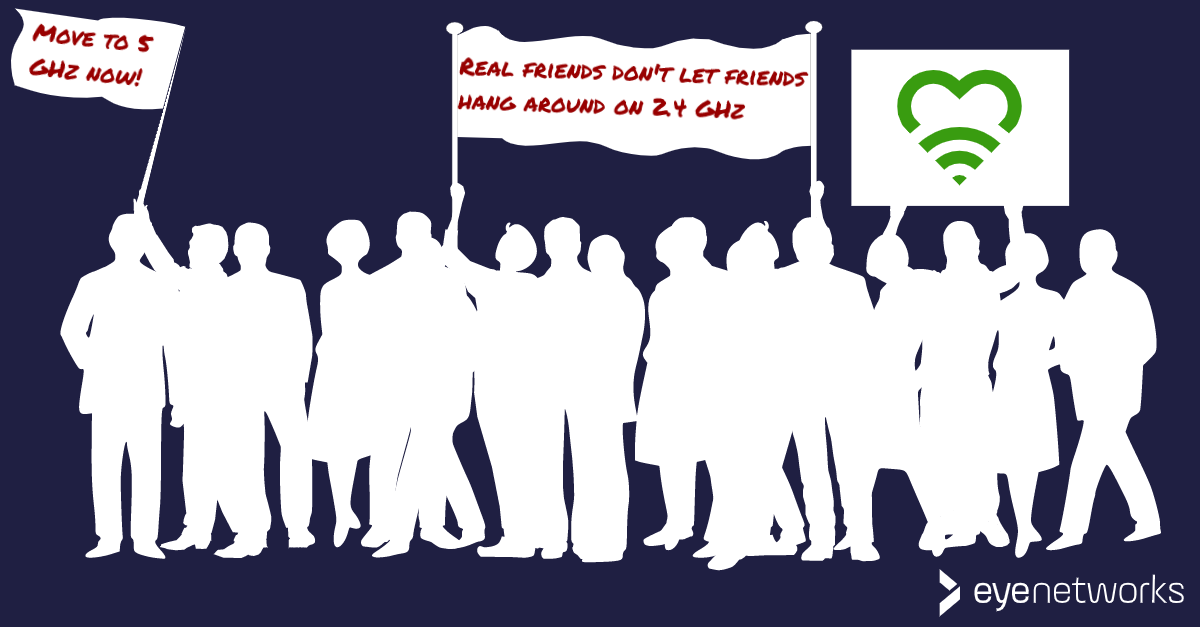Do you get reliable speed and performance, or is streaming laggy even on new wifi gear? You may be connected to 2.4 GHz – which isn’t a good place to be hanging around.
What Are 2.4 And 5 GHz?
A frequency band is a specific area of the radio frequency spectrum. The two most important frequency bands used for wireless internet access are 2.4 and 5 GHz.
- 2.4 GHz has been in use the longest and also has the signals with the longest reach. The flip side is that this frequency band is very exposed to interference and does not allow for high speed data transmission.
- 5 GHz has a shorter range, but less interference, more channels to choose from, and higher speeds.
Wireless access points usually have two radios, one for each frequency band. This lets the same wifi equipment support most types of connected devices at the same time.
The 2.4 GHz band is now so filled up with interference, especially where there are many neighbors, that one should really only use this frequency band if it is absolutely necessary. Any device that CAN be on 5 GHz, SHOULD be on 5 GHz.
However, we know that far too many devices are connected to 2.4 when they should be on 5 GHz. Expensive, high quality equipment is popular and widespread, but users still spend an unfortunate amount of time connected to unnecessarily bad wifi.
So What Should Be Connected To 5 GHz?
All new computers, smartphones, tablets, and so on support and should connect to 5 GHz to get the highest possible speeds and most stable performance.
What’s Left On 2.4 GHz? Can I Just Turn It Off?
There are still plenty of older devices around that only support 2.4 GHz. Many new smart devices such as heaters and bathroom scales that are internet connected, also only support 2.4 GHz. This is not a big deal as long as they are within good coverage, as most such devices do not need high speeds or big data transfers.
We do not recommend turning off 2.4 GHz, only ensuring that as few clients as possible connect.
Make sure that everyone in the household using wifi on mobiles, computers, and tablets, are connected to 5 GHz. It can be helpful to make the devices forget/remove the password for the 2.4 network so that they don’t log back on automatically.
How Do I Know Which Frequency Band I Am Connected To?
Equipment makers have not put much thought or effort into this being visible and understandable to users, so it is not strange or unusual not to know where you are connected.
If your broadband provider has given you two different SSIDs and/or there are two such network names printed on a sticker on your router, there is most likely one SSID per frequency band.
Often a reference to the band will be baked into the name with a number 2 or 5:
VendorNameWifi2 and VendorNameWifi5G.
If you cannot deduce the frequency name from the network name, here is how to check:
- Mac OS X: Hold the Option key and click the wifi icon in the upper right corner of your screen. The channel and frequency band will be visible in the middle of the list of wifi information.
- Windows 10: Go to Settings > Network & Internet > click on the SSID and then Properties.
- iOS: Use the AirPort utility to check on channel and wifi info for your current network. ( (Read more about using the AirPort utility as a wifi scanner here.)
- Android: Some versions of Android will display this as network information in the settings for the wifi network you are connected to.
I Only Have A Single Network! What Do I Do?
If you only have 1 SSID and 1 password, this hopefully means that you have a wifi network with band steering, which is available both in individual routers and mesh networks. With band steering you always use the same SSID and password to connect, and the network determines which band the device should be on. This is why band steering means better wifi.
In some cases, both frequency band may have been assigned the same SSID and password without band steering being present. This is unfortunate, as there is no controlled redirection of devices. In such cases the router setup should be changed to have separate names for each frequency band, so that it is possible to directly select the best band.
You can read more about SSID setup here: How to choose the best SSID for your wifi.
I Don’t Know What Kind of Network I Have Or What To Do!
If you have a wifi solution delivered by your broadband provider, get in touch with their customer support. It is in the service provider’s interest that customers get the best possible experience from the equipment they deliver! And if your wifi does not come from your broadband provider – they may be able to help you with a better solution.
Article by Jorunn Danielsen
